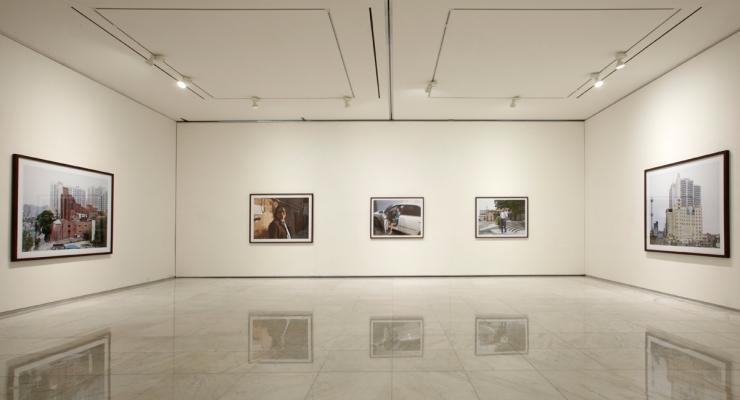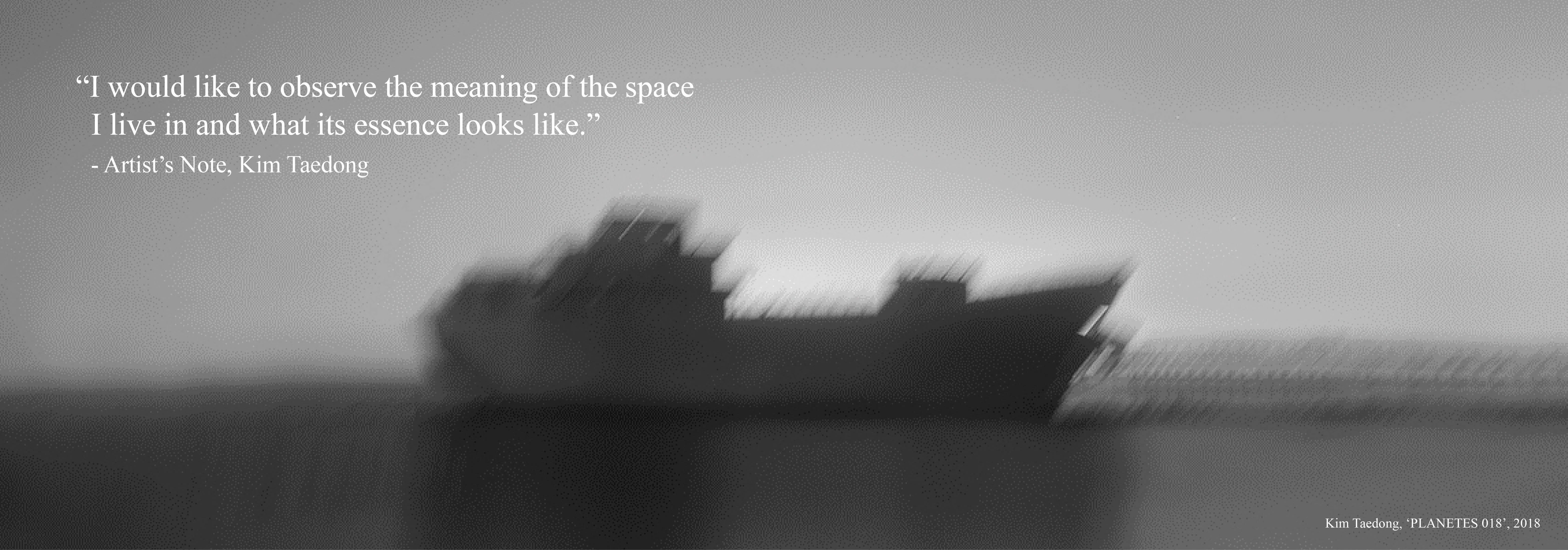The images in Kim Taedong’s photographs might appear familiar at first sight. Kim’s works depict stars floating in the night sky, suburban landscapes unfolding in the frame, and people encountered on the street. Nonetheless, the artworks have a somewhat eerie atmosphere that induces anxiety and tension.

Artist Kim Taedong. © 월간VDCM
Through these visible images, Kim attempts to capture the boundaries underlying in those images. In this context, the boundary may be the outskirts of a city; the dawn between day and night; the divided border areas between North and South Korea; or the dividing line between the past and present at historic war sites.

Kim Taedong, 'Symmetrical-005,' 2010, Archive Pigment Print. Courtesy of the artist.
Among these boundaries, the artist has long been fascinated by the city’s borders. An example is the Symmetrical series, which has been going on since 2010. Kim began this series while working in Flushing, New York, a neighborhood in north-central New York City where many Korean and Asian immigrants reside. The region is located in one of the world’s largest cities, but the outdated sign designs and old buildings are the exact opposite of what many people associate with New York City, and to South Koreans, the area is reminiscent of Korea in the 1980s. By photographing the Flushing area and its inhabitants, Kim captures the subtle contrast between what we imagine a metropolitan city to be and what it actually is.

Kim Taedong, 'Day Break-044,' 2011, Archival Pigment Print. Courtesy of the artist.
Day Break, which began in 2011, and Break Day, which started in 2013, also capture the unusual features of the cities. Instead of New York, the two series capture the landscapes of Seoul.
Even one of the busiest cities rests from midnight to sunrise. The Day Break series depicts the deserted city at dawn and the wandering strangers who inhabit it. By photographing these individuals in the city’s darkened slumber, Kim emphasizes a peculiar and unusual urban scene.
On the other hand, the Break Day series depicts urban environments during the day. Yeonsinnae is a border neighborhood of Seoul where the artist spent his childhood. It is a place where old and new cityscapes collide, as urban redevelopment projects are taking place in Yeonsinnae, which is more of an old town than a metropolitan city. Along the city’s perimeter, the artist captures bizarre landscapes, strangers, and objects.

Exhibition view of "Kim Taedong: DAY-BREAK-DAYS" at Ilwoo Art Space, Seoul. Oct. 31, 2013 - Dec. 24, 2013. Courtesy of the artist and Ilwoo Art Space
In 2014, Kim created the Club S series during his visit to Tokyo, Japan. After discovering a small K-pop bar, he frequently visited to collect information about the city. Later, he realized that the location was frequented by Korean tourists, Koreans living in Japan, Korean-Chinese, Japanese, and other foreigners who appreciated Korean culture. Kim thought that this small bar was like a crack in the city or a tiny island where people from all walks of life could gather. To capture this in his artwork, Kim took photographs of the people he met at a bar in downtown Tokyo.
Later, with the Rifling and Planetes series, he expanded the concept of boundaries from cities to war zones.
In the Rifling series, artist Taedong Kim took pictures of the bizarre countryside along the war sites near the Gyeongwon Line (Dongducheon to Baekma Highlands) or the DMZ area. In the nighttime photograph, bullet fragments, a woman in a military uniform, and a broken wall in a village adjacent to a US military base create a scene unique to the region. As implied by the title of the series, Kim attempts to convey the tension in the DMZ region by unraveling images resulting from the division between North and South Korea.

Partial exhibition view of "Kim Taedong: Planetes" at Amado Art Space/Lab. Nov. 19, 2019 - Dec. 20, 2019.
Kim Taedong, 'ΠΛΑΝΗΤΕΣ, PLANETES project,' AU-007 67cm x 50cm Archival Pigment Print.
The Planetes series began in 2017, and the works have since spread to numerous war zones across the nation. When a camera is set to focus on the stars, the landscape is left with as many ridges as the star’s path. In comparison to the sky, the war ruins, decommissioned weapons, and village landscapes are blurry in the photographs, creating tension and a sense of urgency. Kim states, “As a still image of the stars has been turned into one moment by multiple points in time, I wanted to capture the passing of time in human civilization as embodied in these shaken traces of history.”

Kim Taedong. Courtesy of the artist.
Kim Taedong (b. 1978) decided to pursue a career as an artist after being chosen as one of the top three artists in the 4th KT&G SKOPF Artist of the Year competition (KT&G Sangsangmadang, Korea). Since then, he has won the 4th Ilwoo Photography Award of the Exhibition Division (Ilwoo Foundation, Korea) and held his solo exhibition at Ilwoo Space (Seoul, Korea) in 2013 as part of the award. Kim was also the recipient of the 6th Amado Photography Award (Amado Art Space/Lab, Korea) in 2019 and held his solo exhibition at the space in the same year.
Kim has also participated in group exhibitions held at the Culture Station Seoul 284 (Seoul, Korea); the National Museum of Modern and Contemporary Art (Seoul, Korea); the Hara Museum of Art (Tokyo, Japan); the Ullens Contemporary Art Center (Beijing, China); the Art Sonje Center (Seoul, Korea); and the Buk Seoul Museum of Art (Seoul, Korea).




















